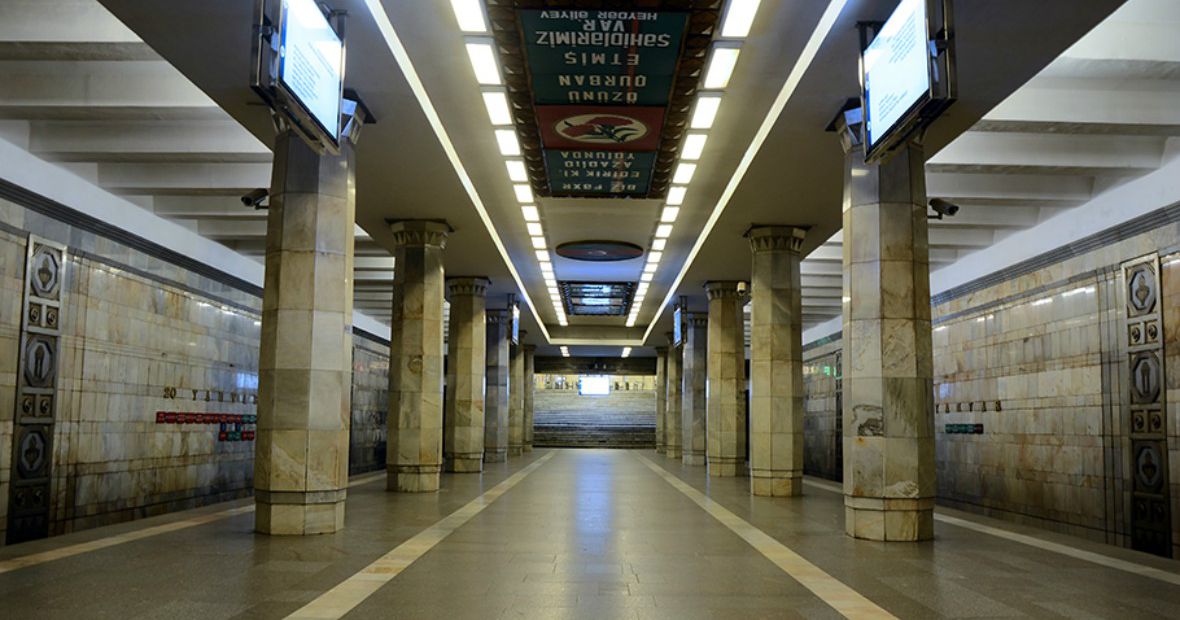
December 31, 1985
Green
100
"20 January" square
Konstantin Senchikhin, Huseynaga Huseynov (painter), Shukur Abbasov
Inaugurated: December 31, 1985
Green line
Commissioning date: December 31, 1985.
Address: “20 Yanvar” square.
Project name: “XI Gizil Ordu meydani” (until 27 April 1992).
Construction profile: shallow-level basement, 2 rows, 32 reinforced concrete columns, island type.
Length of tracks: 100 m.
Architects: K.Senchikhin, Y.Huseynov.
The station was formerly named after the square located above the station in honor of the 11th Red Army, which was actively involved in the establishment of the Soviet Rule. There was also a monument constructed in the square in honor of the 11th Red Army.
When the Soviet Rule was collapsing, Soviet troops entered Baku on the night of 19th -20th January,1990, committed a massacre in the name of restoring stability in the city. These bloody events became a turning point, accelerating Azerbaijan's steps towards independence.
After independence, the station was renamed "20 Yanvar" in remembrance of those events.
On the walls of the station's cashier's hall are inscribed the names of the victims of "20 January" bloody event and the terrorist act committed at the station, along with the corresponding thematic compositions.
The ceiling of the platform is made of interchangeable rectangular and circular boards. The flag of the Republic of Azerbaijan is inscribed on the circular boards, while the rectangular boards are carved with the events occurring that night:
- Azerbaijani people will never forget January 20th martyrs;
- Martyrs sowed the seeds of freedom into soil with their dead bodies;
- The heroism of our martyrs, and their spirit will always live in our hearts;
- We are proud that we have martyrs who died for the sake of freedom;
- The most sacred and eternal monument to the martyrs of January 20th is the independence and freedom of our people.
On the rectangular boards, in between these expressions, a pair of carnations is engraved on a white board with a red background.
Arranged in rows along the ceiling, these boards are surrounded by rectangular lights on each side.
The floor of the station is covered with a white marble stripe in parallel to these boards, which logically complements the overall composition. On the metal boards along the station's track walls are engraved drawings of the eternal torch monument erected at the Alley of Martyrs.
The columns of the platform all the way from the bottom up are designed in such a way that they were carved twice, with the lower part of the columns seeming small.
The part that joins the ceiling opens in the form of a national ornamental grip, as if puncturing the ceiling.
Since three ET-5 type escalators in the first lobby of the station were expired, they started to be replaced since July 1, 2016. They have been replaced by a two-row “Tugela” escalator manufactured by “Thyssen Krupp”, Germany. A stone staircase was built in place of another escalator. On November 8 of the same year, the first lobby with new escalators was reopened for passengers’ entry and exit. Two “Tugela” escalators were installed here, and a stone staircase was built in place of the third escalator.
During the same period, the marble-granite coating of the floors and walls were renovated, and turnstiles, electrical equipment and lighting systems were upgraded in the first lobby. The commemorative boards on the walls with the names of innocent victims of January 20, 1990, and those killed in the terrorist act, commited on March 19, 1994 at this station, were redesigned.
In general, the station has become one of the symbols of independence. On the night of the bloody January, the Metro employees played a special role in preventing the larger scale of brutality of the Soviet army. As a result of heroism demonstrated at that night, thousands of people were saved from becoming innocent victims, the first aid was delivered to the injured, who were hospitalized from here. Besides, Metro was the only shelter for people who ran away from the bullets and persecution.
Every year on January 20, the National Day of Mourning is commemorated at this station in a special way. The night before the day of commemoration, the platform is embellished with carnations arranged in a special literary and artistic composition. Throughout the day at the station, the employees of Metro guard this composition. At 12:00pm, the Metro management holds a minute’s silence at the station. All the trains on the tracks are brought up at the stations to sound their whistles for a minute. On January 20, all stations are decorated accordingly, and the corresponding music tracks are played. The bloody events at " 20 Yanvar" station are not limited to those which happened on the day the station was named after. On March 19, 1994, at 1:00 pm, an explosion occurred on the first carriage of the train while in halt at the station. As a result of the terrorist attack,14 people were killed and 49 injured. Rafig Babayev, People’s Artist of Azerbaijan, was among those killed. The boards dedicated to the victims of that terrorist act are displayed on the wall of the station's cashier's hall.
A piece of national mugam "Bayati Shiraz" is played on the trains arriving at the station.